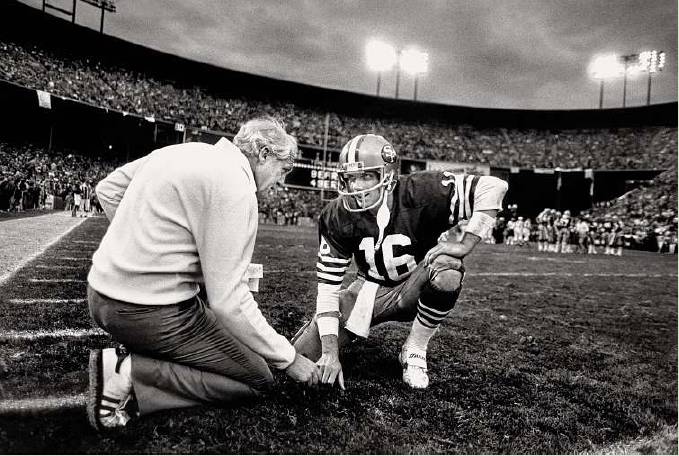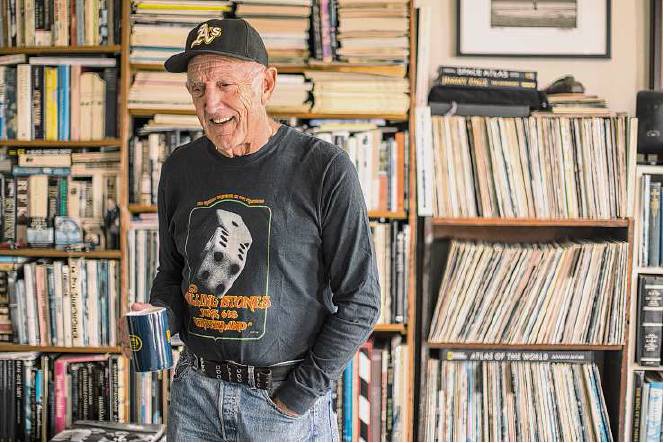EYES THAT FIND ICONIC MOMENTS
Zagaris was given total access to 49ers in 1979 and has been the team’s photographer ever since
ANN KILLION COMMENTARY
A photographer’s craft is timing. The split-second snap that captures the essence. The moment that lasts generations.
Michael Zagaris has always had uncanny timing, an ability to be there when stories are born. As a high school kid at Bellarmine, in the 1950s, he talked his way onto the 49ers sidelines at Kezar Stadium and into the Palo Alto hotel rooms of the visiting Green Bay Packers, bringing Max McGee and Paul Hornung ice and snacks for their boozy card games.
Fifty-four years ago, he was a young campaign volunteer, who slipped on what he thought was cooking oil in the kitchen of the Ambassador Hotel in Los Angeles. It turned out to be blood; Zagaris was just feet from where his hero Bobby Kennedy was assassinated.
That event changed Zagaris’ life but not his sense of timing. The next day he quit Santa Clara Law School, eventually quit his marriage and white-picket fence lifestyle, and headed to the Haight-Ashbury. He began hanging out at the Fillmore, connecting with the English music scene, befriending the likes of Peter Frampton and Eric Clapton. The result was a career as a rock ’n’ roll photographer traveling the world.
“I never considered myself a photographer,” said Zagaris, known to all as “Z” or “Z-man.” “But I had a camera. And the camera was my entree.”
No instance of Zagaris’ timing was better than when, in 1979, he walked into the Redwood City office of the new coach of the 49ers and asked Bill Walsh for total behind-the-scenes access.
And, astonishingly, he got it.
Forty-four seasons later, Zagaris remains the 49ers’ team photographer (he is also the team photographer for the Oakland A’s). Zagaris’ ballsy request of Walsh allowed him to chronicle the 49ers’ dynasty and its aftermath, up to present day.
The result is a spectacular new book, “Field of Play: 60 years of NFL photography.” Published by Petaluma’s Cameron + Company, with text by Steve Cassady, it contains a forward by Joe Montana, essays by Fred Biletnikoff and Ronnie Lott and an afterword by social activist and 49ers consultant Harry Edwards.
While the book also includes Zagaris’ early work in the NFL and with the Oakland Raiders, its heart is the 49ers’ dynasty. His unequaled access is visible: the photos capture not only the joy and playfulness of the teams, but the pain, the needles, the concussions, the hurt behind all the wins.
Zagaris committed to the book during the pandemic, when he began going through the thousands of photographs that fill his Haight-Ashbury flat.
“I always had in the back of my mind that I wanted to do this, but I waited because I wanted it be true to the whole journey,” Zagaris, 77, said. “I knew it would piss some people off, probably the people at the top. But at a certain point, what can they do? Fire you? I’ve had a great run.”
He has lived in the Haight for more than five decades and his flat, with a soundtrack of news coming from the BBC, is stuffed with books, record albums and photos, a story and an anecdote spilling out of every corner.
“Isn’t his apartment just like him?” said Montana.
It is. Colin Kaepernick kneels on the sideline on one wall. Bob Dylan poses with Irish children in a doorway on another. Above Zagaris’ desk are photos of Kennedy, Barack Obama, Roberto Clemente, and a large photo of the protest at the 1968 Mexico City Olympics, signed by its architect, Edwards.
While a picture is worth 1,000 words, Zagaris doesn’t just let his photos do the talking. His stories of adventures and mishaps — complete with accents and impersonations of his main characters — are legendary. His memory is like his work: photographic. The 49ers were a team of stars, but the most entertaining member of the group has usually been Zagaris.
“When you are in the same room with Michael, you know it,” Montana wrote in the book’s foreword. “The best place to be is within listening distance to hear his endless stream of wild tales from his firsthand experiences in sports and rock ’n’ roll.”
Zagaris, a leftist rule-breaker, is not exactly who one would expect to chronicle the conservative NFL. But he loves football as much as arguing politics or telling stories about dropping acid.
“Football really is who we are as a country,” Zagaris said. “It combines violence and pageantry and it’s almost like a religion. Most people don’t have the job they want or the relationship they want, so they live through their teams.”
Football was his first love, and he gravitated back to it during his rock ’n’ roll years. He worked the sideline for the 49ers during some of the franchise’s desperate years. He even had to forge former general manager Joe Thomas’ name on a check, because he hadn’t gotten paid in months.
When Walsh was hired, Zagaris appealed to the coach’s cerebral side.
“I knew he was an academic, and we talked about history, and preserving historical moments,” Zagaris said of their first meeting, when he made his bold request. “My thing is, if I’m gonna strike out, at least it’ll be a swinging strike. And that’s how it was when I talked to Bill.”
Starting that first season, Zagaris had full access. To the final days of O.J. Simpson’s career, to the goofy rookie Montana, to the birth of a dynasty.
“When I was just trying to find my way around during my rookie season of 1979, (he) became a familiar face and one of the people who helped me get comfortable in my new surroundings,” Montana wrote.
And Montana noticed an astonishing thing. Though you always knew where Z was, always wanted to hear his outrageous stories, he had a way of becoming invisible.
“You always knew Michael was around, except — and here’s the crazy part — when he was working as the 49ers team photographer,” Montana wrote. “In those settings he was able to blend in, and you never knew he was there until later when you saw his photos.”
Montana is the star and center of the book. Zagaris claims not to have a favorite subject, but the book tells a different story.
“I live in the moment; my favorite is who I’m getting both a connection to and energy from,” he said. “But Joe was a prankster. Joe was cool. But that was the energy of the moment, of the time. I just tried to hold up the mirror.”
Zagaris won the trust of his subjects, and their bond continues. Many, including Montana, showed up to his book signing in San Francisco last week.
Over the years, long after Walsh’s departure, 49ers head coaches have continued to grant access to Zagaris. The only one who denied him was Jim Harbaugh, who told him he could “shoot through the locker room door.”
“A distraction,” Zagaris remembers, his eyes wide. “I told him, ‘We went to five Super Bowls and won them. I’ve been to World Series with the A’s. But I can’t be in because of the distraction? This isn’t about you; this is about the history of the league.’ ”
Toward the end of Harbaugh’s tenure, Zagaris’ access improved slightly. But as soon as Harbaugh was gone, he was fully back in. The book contains photos as recent as the snowy playoff game in Green Bay last January. The book feels like a time capsule; it seems unlikely, in today’s rigid and controlling NFL, that photographers will ever get this kind of access again.
Perhaps Zagaris’ most iconic shot, “Master and Mentor,” is the cover photo of the book. Montana and Walsh kneel on the Candlestick grass together, in 1985, mid-NFC Championship Game.
The lore has always been that they were drawing up a play in the dirt. The truth is shared by Montana: the quarterback was too exhausted to stand, so the coach came down to him.
“Bill took a knee to meet me on my level in that moment, and in many ways, that was symbolic of his leadership style,” Montana wrote.
And in many ways, the photo is symbolic of Zagaris’ style and his sense of timing. This quiet moment at the far end of the field tells you more about the 49ers’ dynasty than any action picture.
A shot that captures the essence of the thing.
Ann Killion is a San Francisco Chronicle columnist. Email: akillion@sfchronicle.com Twitter: @annkillion
“If I’m gonna strike out, at least it’ll be a swinging strike. And that’s how it was when I talked to Bill (Walsh).”
Michael Zagaris, on requesting access to photograph the 49ers





